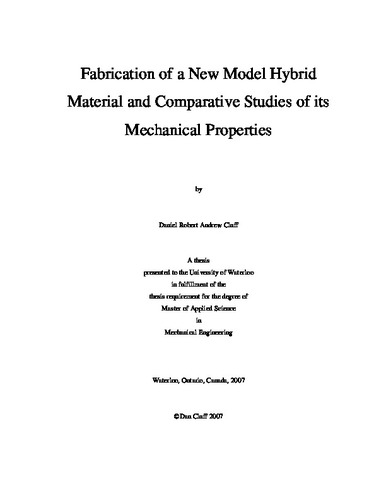| dc.contributor.author | Cluff, Daniel Robert Andrew | |
| dc.date.accessioned | 2007-07-27 18:03:56 (GMT) | |
| dc.date.available | 2007-07-27 18:03:56 (GMT) | |
| dc.date.issued | 2007-07-27T18:03:56Z | |
| dc.date.submitted | 2007 | |
| dc.identifier.uri | http://hdl.handle.net/10012/3136 | |
| dc.description.abstract | A novel aluminum foam-polymer hybrid material was developed by filling a 10 pore per inch (0.39
pores per millimeter), 7 % relative density Duocel® open-cell aluminum foam with a thermoplastic
polymer of trade name Elvax®. The hybrid was developed to be completely recyclable and easy to
process. The foam was solution treated, air quenched and then aged for various times at 180˚C and
220˚C to assess the effect of heat treatment on the mechanical properties of the foam and to choose
the appropriate aging condition for the hybrid fabrication. An increase in yield strength, plateau
height and energy absorbed was observed in peak-aged aluminum foam in comparison with underaged
aluminum foam. Following this result, aluminum foam was utilized either at the peak-aged
condition of 4 hrs at 220˚C or in the as-fabricated condition to fabricate the hybrid material.
Mechanical properties of the aluminum foam-polymer hybrid and the parent materials were assed
through uniaxial compression testing at static ( de/dt = 0.008s-1 ) and dynamic ( de/dt = 100s-1 ) loading
rates. The damping characteristics of aluminum foam-polymer hybrid and aluminum foam were also
obtained by compression-compression cyclic testing at 5 Hz. No benefit to the mechanical properties
of aluminum foam or the aluminum foam-polymer hybrid was obtained by artificial aging to peakaged
condition compared to as-fabricated foam. Although energy absorption efficiency is not
enhanced by hybid fabrication, the aluminum foam-polymer hybrid displayed enhanced yield stress,
densification stress and total energy absorbed over the parent materials. The higher densification
stress was indicative that the hybrid was a better energy absorbing material at higher stress than the
aluminum foam. The aluminum foam was found to be strain rate independent unlike the hybrid where
the visco-elasticity of the polymer component contributed to its strain rate dependence. The damping
properties of both aluminum foam and the aluminum foam-polymer hybrid materials were found to
be amplitude dependant with the hybrid material displaying superior damping capability. | en |
| dc.format.extent | 2308342 bytes | |
| dc.format.mimetype | application/pdf | |
| dc.language.iso | en | en |
| dc.publisher | University of Waterloo | en |
| dc.subject | Aluminum Foam | en |
| dc.subject | Dynamic Compression Testing | en |
| dc.subject | Energy Absorption | en |
| dc.title | Fabrication of a New Model Hybrid Material and Comparative Studies of its Mechanical Properties | en |
| dc.type | Master Thesis | en |
| dc.pending | false | en |
| dc.subject.program | Mechanical Engineering | en |
| uws-etd.degree.department | Mechanical and Mechatronics Engineering | en |
| uws-etd.degree | Master of Applied Science | en |
| uws.typeOfResource | Text | en |
| uws.peerReviewStatus | Unreviewed | en |
| uws.scholarLevel | Graduate | en |

